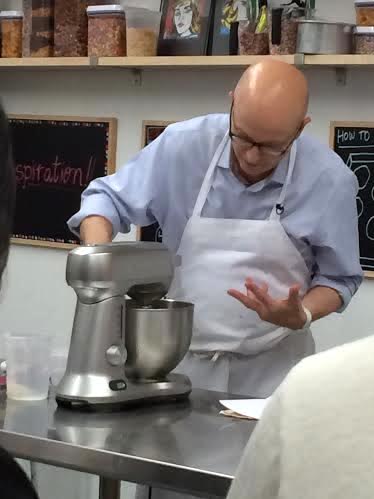
Pie, like all collections of biological material, is subject to physical laws, and thus provides opportunities for insights into biophysics—although most laboratory experiments don’t end up quite so tasty. On Friday evening the Momofuku Milk Bar in Williamsburg, Brooklyn hosted an exploration of the science of pie-making at the 2014 World Science Festival program Biophysics? More Like PIE-O-Physics! Biophysicist Amy Rowat, Milk Bar founder Christina Tosi, and White House pastry chef Bill Yosses were all on hand to explain the chemical and biophysical principles that turn flour, water, fat, filling and heat into a delectable pie.
Pie crust begins with flour, which consists of starch (sugars) and protein molecules. When water is added, it rearranges the molecules in the flour to “form a network of proteins, like springs, between the molecules of starch,” Rowat said. This network, called gluten, provides structure and mechanical stability to the dough.
Guests got to experience the flavor and texture of gluten firsthand by trying the Milk Bar’s pie crust crumbs, which they incorporate into layer cakes and other desserts. (They were buttery, flaky, and held a satisfying mixture of sweet and salty in every crunchy bite.)
Next came the biophysics of pie filling. It turns out that the biology of the ingredients you are using to fill up your pie will affect the texture and flavor in certain ways. Plants have a thick cell wall, which can yield a crispy texture (think the crunch of biting into an apple). But “when fruit starts to cook, you get phase transitions, such as water converting to steam,” Rowat said. “Heat essentially melts some of the scaffolding holding together some of the cell wall.” That cellular breakdown creates the soft and gooey texture of pie filling that we all know and love.
Even the way the fruit is sliced impacts the texture of a pie’s filling. When the water in an apple slice evaporates in the oven, the apple becomes tender and begins to wilt. Cutting apples in extremely thin slices mediates this effect by preventing the pieces from falling in on each other, and ultimately keeps the pie filling level, rather than sunken in. (For further investigation, the audience sampled an apple filling and a blueberry filling, both of which proved that the chefs’ chemical insights produce delicious results.)
Finally, the pie moguls explained some of the important chemical and biophysical details underlying the baking of a pie. Substances expand in hot temperatures, because the heat makes their molecules vibrate faster. So when a pie is put into the oven, the water molecules take up more space as they convert to steam. Creating holes, or steam vents, in the crust allows the expanded matter to be released and protects the pie from exploding.
Tosi stressed that it’s important to not be afraid of overcooking pie; you really want to make sure there’s adequate time for all of the chemical reactions that contribute to a pie to run through their paces. “You need to give the water molecules every last second to expand and create those air pockets” that will yield a perfect, flaky crust, Tosi said.
Comments